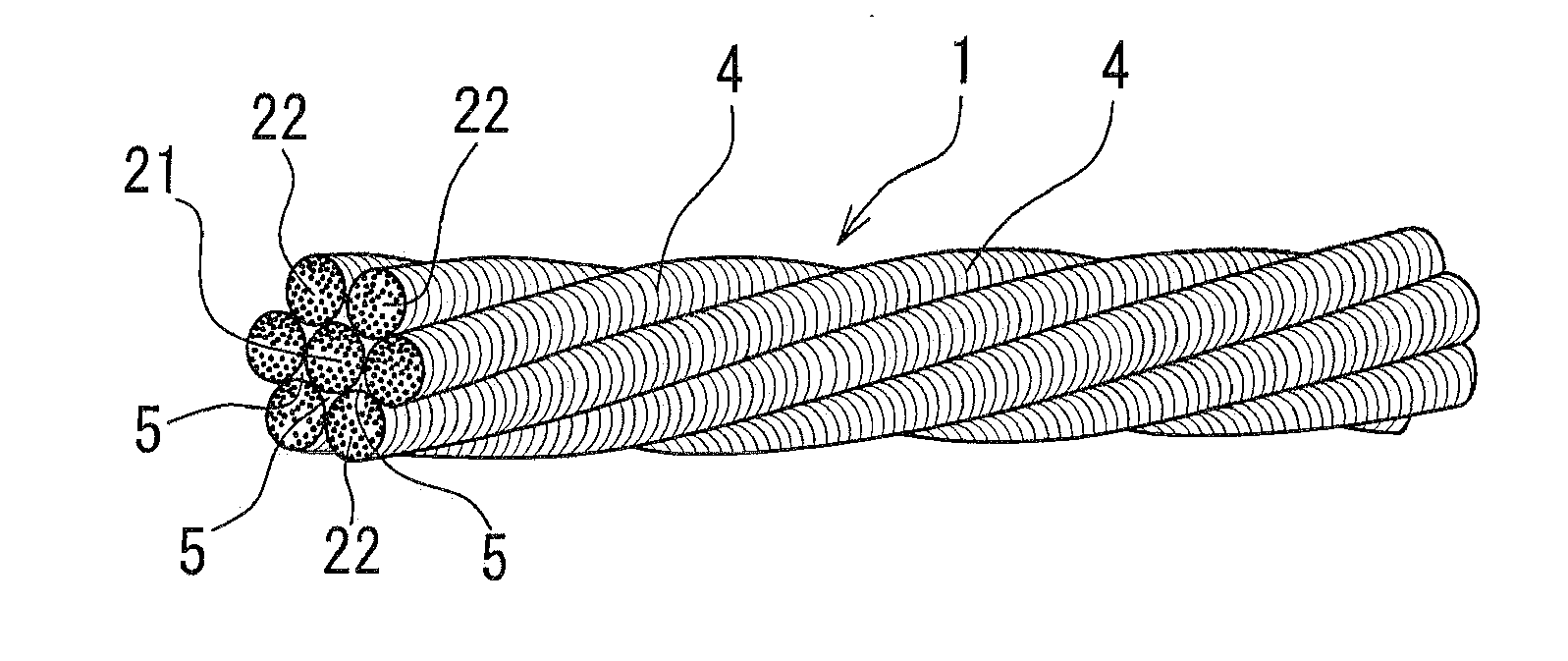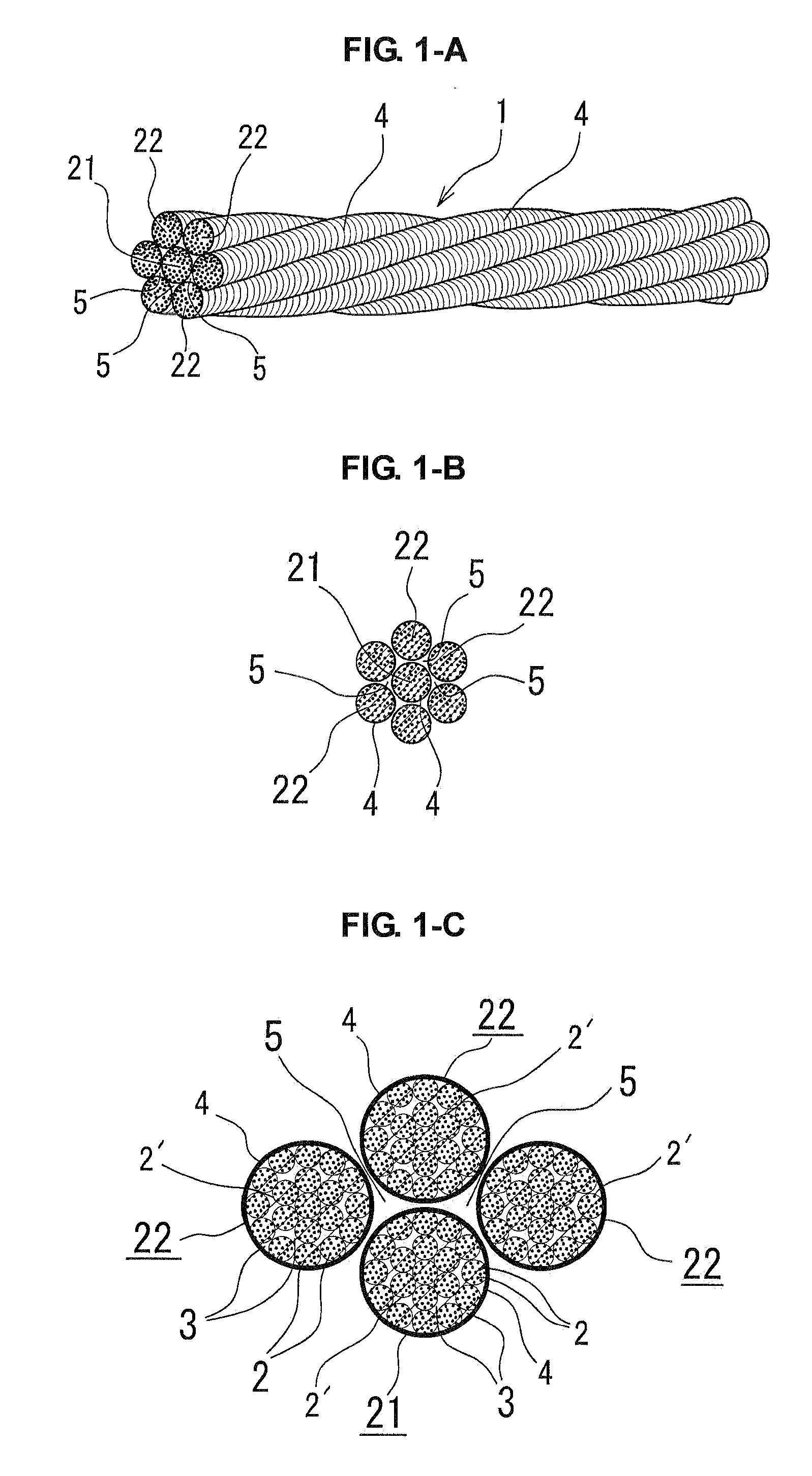Fiber composite twisted cable
a fiber composite and twisted cable technology, applied in the field of fiber composite twisted cable, can solve the problems of large reel, impaired structure, and cable flexibility that the cable should have under normal circumstances, and achieve the effects of convenient transportation and workability, superior transportability and workability, and suitably alleviating the constraining for
- Summary
- Abstract
- Description
- Claims
- Application Information
AI Technical Summary
Benefits of technology
Problems solved by technology
Method used
Image
Examples
second embodiment
[0073]Referring now to the attached drawings, the invention will be described.
[0074]FIG. 9A shows a fiber composite twisted cable 100 having a structure of 1×19 including nineteen strands, and having a diameter of 18 mm according to the second embodiment of the invention. The composite twisted cable 100 is configured as described in the first embodiment, and the strands are separated and independent without being bonded to each other so that gaps for allowing independent behaviors of the respective strands when the cable is bent are formed between a core strand and side strands surrounding the same.
[0075]The composite twisted cable 100 includes a single core strand 111 and six first layer strands 112 twisted so as to surround the core strand 111, and also includes twelve second layer strands 113 twisted on an outer periphery thereof.
first embodiment
[0076]The respective strands 111, 112 and 113 have a configuration including a plurality of twisted prepregs, which are formed of bundles of PAN carbon fiber impregnated with thermosetting resin as in the first embodiment, and outer peripheries of the strands are covered with a fiber yarn 400 wound therearound at an angle close to a right angle with respect to the axial direction of the strand in the high density.
[0077]Reference numerals 500 designate five substantially triangle shaped gaps surrounded by the core strand 111 and the first layer strands 112 and 112. By the existence of the gaps, the first layer strands 112 and 112, and the core strand 111 are separated and independent and are only in contact with each other in the longitudinal direction without being bonded to each other. The adjacent first layer strands 112 and 112 are also separated and independent in the longitudinal direction without being bonded to each other.
[0078]Reference numerals 501 designate six substantial...
third embodiment
[0082]Referring now to the attached drawings, the invention will be described.
[0083]FIG. 10A shows a fiber composite twisted cable 200 having a structure of 1×37 including thirty seven strands, and having a diameter of 28 mm according to a third embodiment of the invention.
[0084]The cable 200 includes a single core strand 211 and six first layer strands 212 twisted so as to surround the core strand 211, includes twelve second layer strands 213 twisted on an outer periphery thereof, and further includes eighteen third layer strands 214 twisted on the outer periphery thereof.
[0085]Reference numerals 500 designate five substantially triangle shaped gaps surrounded by the core strand 211 and the first layer strands 212 and 212. By the existence of the gaps, the first layer strands 212 and 212, and the core strand 211 are separated and independent and are only in contact with each other in the longitudinal direction without being bonded to each other.
[0086]Reference numerals 501 designat...
PUM
 Login to View More
Login to View More Abstract
Description
Claims
Application Information
 Login to View More
Login to View More - R&D
- Intellectual Property
- Life Sciences
- Materials
- Tech Scout
- Unparalleled Data Quality
- Higher Quality Content
- 60% Fewer Hallucinations
Browse by: Latest US Patents, China's latest patents, Technical Efficacy Thesaurus, Application Domain, Technology Topic, Popular Technical Reports.
© 2025 PatSnap. All rights reserved.Legal|Privacy policy|Modern Slavery Act Transparency Statement|Sitemap|About US| Contact US: help@patsnap.com



